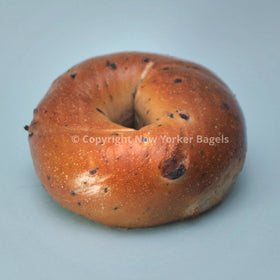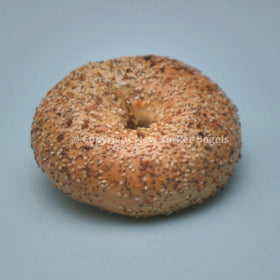The original New York bagel has been referred to as a “cement doughnut” or “Brooklyn Jawbreaker”? The dark brown chewy crust, dense crumb and characteristic flavor of New York bagels can be attributed to the use of malt syrup.
But what is malt? Barley is cleaned and graded to size, dumped into steep cylindrical tanks with conical bottoms, and covered with water. The steeped grain is then transferred to germinating beds for an average of four to seven days before being placed in kilns and dried. This stops germination without killing the enzymes.
Finally, the dried, malted grain is crushed and mashed with a little water to hydrolyze the substance into fermentable sugars, resulting in a syrup which can be evaporated to the desired strength and thickness.
Most malts are just a little more than half as sweet as sucrose (white table sugar). Malts are used to smooth out chocolate and cocoa products as it mellows and rounds the flavor, and can be found in a wide variety of products such as infant foods, breakfast cereals, saltine crackers, breads, rolls, granola cereals and bars, rice cakes, pretzels, beverages, ice creams, cookies, icings, fillings, soy milk, pet foods and even pharmaceuticals.
Oh, and don’t forget – the New Yorker bagel. Malt contributes a mild sweetness as well as important ingredients such as mineral salts, soluble proteins, dough conditioning enzymes, flavor, color, and nutritive materials. These give us the incredible rich brown crust of the typical New York bagel, while adding flavor and aroma to the finished bagels.
It’s not just looks, taste and smell that are enhanced by malt. Other ingredients in the malt assist in the proofing process, promoting vigorous yeast activity, and speeding up dough conditioning. Malt supplements the amylase in the wheat flour to provide sugar for fermentation, and helps to modify, or relax, the gluten in the wheat flour which makes it easier to handle.
There are even health benefits to eating bagels made with malt syrup. In contrast to bagels made with sugar or high fructose corn syrup, bagels made with malt are better for you. Malt is basically a carbohydrate, which is made up of mostly complex carbohydrates instead of the “sugar” carbohydrates you find in other sweeteners. There’s no fat or cholesterol in malt, and a decent amount of vitamins and minerals.
Some bagel makers use liquid malt which is generally created using a mixture of barley malt and corn grits. The syrup ranges in color from a light tan to almost black. More corn means a lighter malt flavor, while more malt means the dark sweetness is increased.
How does malt account for the browning in the crust? Malt quickly caramelizes with temperature, so the amount and type of malt used can have a huge impact on the finished crust color. Other sweeteners can result in a longer required bake time, resulting in a hard, unpalatable product. With malt, bagels cook quickly to a brown finish and are still chewy and crumby.
Tired of sad, pale bagels? Choose real New York bagels and enjoy the taste of real malt syrup in every bite!





























